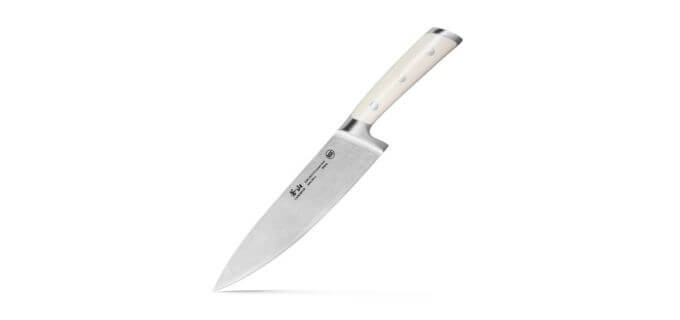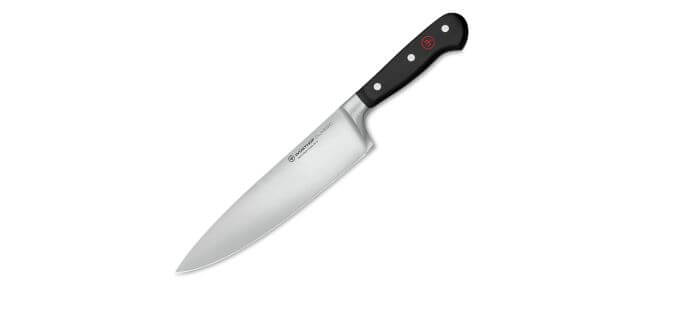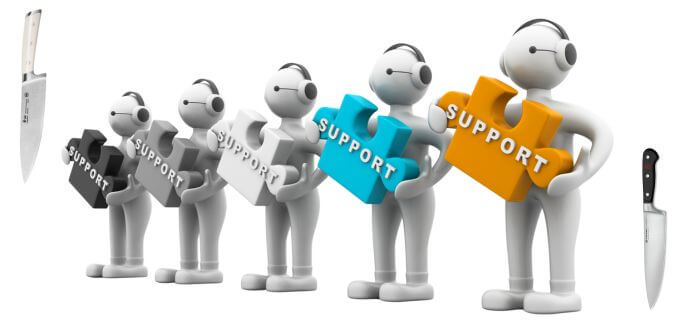Choosing the right kitchen knife set can make a world of difference in your cooking experience. With premium brands like Cangshan vs Wüsthof, both known for high quality, durability, and performance, selecting the best fit for your kitchen can be daunting.
Here, we’ll break down every key factor, from blade materials and handle design to value and warranty, to help you make the most informed choice for your cooking needs.
Quick Comparison Table
Feature | Cangshan | Wüsthof |
Blade Material | German, Japanese, Swedish Steel | X50CrMoV15 high-carbon stainless steel |
Sharpness | 16-degree angle per side | 14-degree angle per side |
Durability | Moderate to high (varies by collection) | High (forged and stamped options available) |
Handle Options | Wood, metal, synthetic, wide variety | Traditional full-tang with various shapes |
Weight | Range from light (stamped) to heavy (forged) | Heavier, balanced feel (forged collections) |
Price Range | Budget to premium | Mostly premium |
Best For | Those who want variety and aesthetic appeal | Cooks who need a durable, professional tool |
Cangshan vs. Wüsthof: Company Background and Craftsmanship

Cangshan
Cangshan is a relatively new player in the knife market, established in 2015 by Henry Liu, but it has quickly gained recognition with prestigious design awards like the Red Dot Award for its innovative approach.
Named after a mountain in southern China, Cangshan blends Eastern and Western influences, which is reflected in its diverse, aesthetic designs and functional diversity.
Their knives are crafted in Yangjiang, China, a region with over 1,500 years of bladesmithing history, and incorporate German, Japanese, and Swedish steel in different collections
Wüsthof

Wüsthof boasts over 200 years of experience, originating in Solingen, Germany—the “City of Blades.” Founded in 1814, Wüsthof remains family owned and is widely respected among professional chefs and home cooks alike.
Each Wüsthof knife goes through a rigorous 40-step forging and sharpening process, ensuring precision, balance, and edge retention. Their knives reflect traditional German design and durability, particularly popular in their iconic Classic and Ikon series.
Design and Ergonomics: Which Brand is More Comfortable?
Cangshan
Cangshan is known for pushing boundaries with aesthetics, offering a variety of handle styles, materials, and color palettes across 25 unique collections. Some of their notable designs include:
- S1 Series: Minimalistic, with sleek white handles that look stunning in modern kitchens.
- N1 Series: Fully metallic, with a hollow steel handle for added balance and comfort.
- Thomas Keller Signature Collection: Developed with Michelin-starred chef Thomas Keller, this line uses Swedish Damasteel Powdered Steel, offering excellent balance and an elegant look.
Each Cangshan knife handle is ergonomically designed with comfort in mind, but the brand also offers a mix of materials to suit different preferences.
Handles may be made of Acacia, Walnut, Teak, Ashwood, or African Blackwood, adding warmth and style to kitchen counters. Cangshan’s variety makes it ideal for those who want to personalize their kitchen setup and value aesthetic versatility.
Wüsthof
Wüsthof embraces a more traditional, consistent design approach, well-suited for those who appreciate the solid feel and weight of German knives. Their most popular collections include:
- Classic: Wüsthof’s signature line with triple-riveted handles, a full tang, and an exposed bolster for excellent balance.
- Ikon: Similar to the Classic line but features ergonomic handles crafted from African Blackwood, a dense, moisture-resistant wood that adds luxury and balance.
- Classic Ikon: A variant of the Ikon collection with synthetic handles, offering similar ergonomic benefits at a lower price point.
- Amici: Features unique Mediterranean olive wood handles, creating a distinct look and natural grip.
Winner: Cangshan wins for variety and modern appeal, while Wüsthof shines with a sturdy, traditional design. For those who want a customized style, Cangshan is the way to go; for a reliable, no-frills grip, Wüsthof offers proven comfort.
Blade Material, Sharpness, and Edge Retention

Both brands use premium-grade materials, but the choice of steel and sharpness angle varies.
Cangshan
Cangshan offers different steel options to cater to varied preferences:
- German X50CrMoV15 Steel: This steel is similar to what Wüsthof uses, offering 58 on the Rockwell Hardness Scale, combining sharpness and durability.
- Japanese VG10 Steel: Harder (Rockwell 60) and slightly more brittle, known for razor-sharp edges and edge retention.
- Swedish Sandvik Steel: High hardness (Rockwell 60-62), corrosion-resistant, and provides excellent edge retention.
Cangshan sharpens its knives to a 16-degree angle per side, balancing sharpness with durability. Their rigorous six-stage heat treatment, developed over years of research, ensures that Cangshan blades remain sharp without chipping easily, suitable for tasks ranging from delicate slicing to heavy-duty chopping.
Wüsthof
Wüsthof exclusively uses X50CrMoV15 high-carbon stainless steel, hardened to Rockwell 58 and sharpened to an impressive 14-degree angle per side.
This angle makes Wüsthof knives slightly sharper out of the box than Cangshan’s, and their forging process adds durability, making these blades ideal for tasks that require precision, like finely slicing vegetables or dicing meats.
Winner: Wüsthof takes the lead with its sharper angle and trusted edge retention. For those seeking maximum durability and easy maintenance, Wüsthof’s single-steel approach may be more appealing.
Performance and Durability
Cangshan Knives: The brand provides both stamped and forged knives. Most collections, like the Y2 and Thomas Keller Signature Series, are forged and can withstand rigorous daily use, while the stamped TG and W Series offer lighter options for those who prefer agile knives. However, Cangshan recommends a gentler approach with harder knives to avoid chipping, which can be a consideration if you need a robust knife for heavier tasks.
Wüsthof Knives: Wüsthof excels in durability due to its rigorous 40-step forging process and full-tang construction. The majority of Wüsthof’s collections are forged, making them highly resistant to wear and tear, even with frequent use. Wüsthof knives retain their sharpness over long periods, making them suitable for heavy-duty tasks like slicing thick cuts of meat or chopping root vegetables.
Winner: Wüsthof is slightly more durable, especially for cooks needing a knife that can handle daily, heavy-duty tasks without frequent sharpening.
Weight and Balance
The weight and balance of each knife brand vary across collections but are generally tailored for different user preferences.
Cangshan
The brand offers both heavier and lighter options, appealing to a broad range of users. Their forged knives, such as those in the Thomas Keller Collection, have a balanced, substantial feel, ideal for those accustomed to a traditional knife weight. For users preferring lighter knives, the stamped TG and W Series provide a lightweight, agile feel suitable for precision tasks.
Wüsthof
Most Wüsthof knives are heavier due to their full-tang, forged construction, which provides stability and balance. Collections like Wüsthof Gourmet offer lighter, stamped knives, making them easier to handle for those preferring lighter blades. Wüsthof’s heavier weight can give cooks a sense of control and is especially useful for precision tasks.
Winner: Cangshan has an edge for those who want more flexibility in weight, while Wüsthof provides a reliable, balanced feel that many professional chefs prefer.
Value for Money
Cangshan
Offers a mix of budget-friendly and premium options, with collections designed to meet various price points. For those who want affordable quality, Cangshan’s lower-cost collections like the TG and W Series are excellent options. Even their higher-end lines, like the Thomas Keller Signature Collection, remain competitively priced, making Cangshan accessible without sacrificing quality.
Wüsthof
As a premium brand, Wüsthof’s knives are generally more expensive. Collections like the Ikon and Classic series represent higher price points, reflecting the brand’s emphasis on durability, craftsmanship, and long-term investment.
Wüsthof’s extensive warranty and long-standing reputation add value, especially for those willing to pay more for a dependable kitchen tool.
Winner: For budget-conscious buyers, Cangshan provides strong quality at various price levels, while Wüsthof is ideal for those seeking a long-term investment in premium cutlery.
Warranty and Customer Support

Both brands offer limited lifetime warranties, covering manufacturing defects and ensuring support for their customers. However, it’s essential to follow care guidelines, as improper use (like dishwasher cleaning) may void the warranty.
- Cangshan: Offers a limited lifetime warranty, covering defects in material or craftsmanship but recommends hand-washing and gentle use for harder-steel knives.
- Wüsthof: Also includes a limited lifetime warranty, with a reputation for honoring it. Wüsthof’s long history and customer service are highly regarded, and they’re known to replace knives with manufacturing issues promptly.
Winner: Both brands offer solid warranties, but Wüsthof’s reputation for honoring their warranty is well-established.
Final Recommendation: Which Knife Brand is Best for You?
Cangshan: If you’re a home chef who values design variety, affordability, and options in terms of steel type and handle design, Cangshan is a fantastic choice. The brand offers multiple collections tailored to different tastes and budgets, making it suitable for those who want a beautiful, functional addition to their kitchen.
Wüsthof: If you’re after durability, consistent performance, and a knife that will stand the test of time, Wüsthof’s classic German craftsmanship is ideal. With a higher upfront cost but long-term value, Wüsthof is perfect for serious home cooks or professionals who prioritize precision and dependability.
Related Topic: We compared two other famous knife brands, Imarku and Henckels
FAQs on Cangshan vs. Wüsthof Knives
What’s the main difference between Cangshan and Wüsthof knives?
The main difference lies in their design approach and heritage. Cangshan, a newer brand, offers a variety of styles with unique handle designs and both Eastern and Western influences, catering to modern aesthetics.
Wüsthof, with over 200 years of experience, is known for traditional German craftsmanship, focusing on durability, sharpness, and consistent performance. Cangshan also offers a broader range of price points, while Wüsthof is generally a premium investment.
Which knives are sharper: Cangshan or Wüsthof?
Wüsthof knives are slightly sharper out of the box, with a 14-degree angle per side compared to Cangshan’s 16-degree angle. This difference makes Wüsthof knives ideal for precision tasks. However, Cangshan knives maintain a balance between sharpness and durability, making them versatile and slightly less prone to chipping than extremely sharp knives.
Are Cangshan or Wüsthof knives better for heavy-duty tasks?
Wüsthof knives are generally more suited for heavy-duty use, thanks to their robust forging process and full-tang construction, making them ideal for cutting tougher ingredients. Some Cangshan collections, particularly those with harder steel, are better for lighter, precision tasks to avoid potential chipping under rigorous use.
Which brand offers more variety in design and handle materials?
Cangshan offers more variety with 25 collections featuring various handle materials like wood, metal, and synthetic, and unique designs tailored to different preferences. This makes Cangshan a great choice for those who want a visually distinct or customized look. Wüsthof, on the other hand, focuses on a classic, ergonomic design with quality materials that prioritize comfort and longevity.
How does the price compare between Cangshan and Wüsthof?
Cangshan offers a broader range of prices, making it accessible for budget-conscious buyers and those looking for premium collections. Wüsthof knives tend to be more expensive, reflecting their reputation for durability, precision, and traditional German craftsmanship. Wüsthof is ideal for those willing to invest in a long-lasting knife, while Cangshan provides quality options at multiple price points.
Leave a Reply